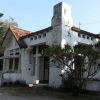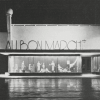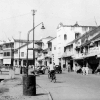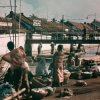
Since the completion of De Bouwploeg building in November 1913 at Entree Gondangdia (now Taman Cut Meutia) the company did not occupy the offices at all. Instead, it used a newly built villa at Boulevard Gondangdia 9 (Jalan Teuku Umar 9) as their main office. The first cracks in the company appeared in 1914. Newspaper Bataviaasch Nieuwsblad published on 29 April 1914 that De Bouwploeg discontinued its activities. The newspaper article also mentioned that the company’s forge, lime kilns and carpenter’s shop would be rented out. Three days later, another newspaper in Batavia/Jakarta pointed out that the end of De Bouwploeg was not difficult to predict. “Again an Indies business established by people incapable of carrying out this task, who suffered from a borderless overconfidence. Courage resulted in recklessness”. However two days later Director Elenbaas explicitly denied the shutdown of De Bouwploeg, and the company indeed continued and also kept publishing advertisements in the newspapers.
Pandhuisdienst
In August 1914 Elenbaas resigned, and he was succeeded by Mr. W.A. van Cuijk. The Bouwploeg building itself was since that month rented out to the Pandhuisdienst. De Bouwploeg still advertised in the newspapers until 1916; afterwards its activities slowly decreased. The company was officially liquidated on 10 September 1920 after the Batavia City Council had decided to purchase all the possessions of De Bouwploeg for 2 million guilders. More than a century later we can still see the contours of the name “NV De Bouwploeg” on the north side of today’s Cut Meutia mosque if the sun shines on the plastered banner. We have increased the contrast of the picture to show it a bit better.





